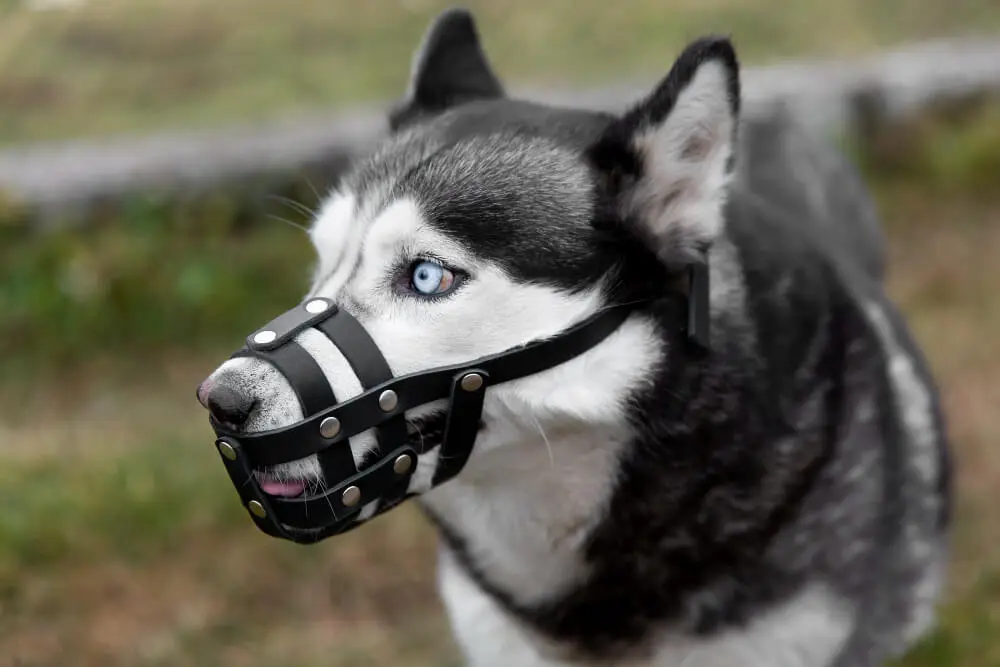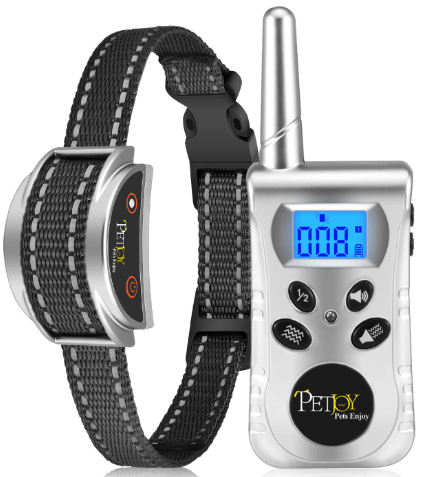Photo: amazon.com
We have discussed cooling collars and martingale collars. One of our earlier posts also covers everything you need to know about dog collars for large dogs. Today, we will focus on a type of collar that has modernized and revolutionalized dog training techniques- vibrating dog collars. Vibrating collars for dogs are innovative devices that harness gentle vibrations’ power to gain your dog’s attention. They provide a humane and effective method of communicating your commands. Here is a comprehensive guide on dog vibration collars, when to use them, and the five best vibrating dog collars.
Vibrating Dog Collar: What Is It and How Does It Work?
Vibrating collars for dogs are a modern tool used in canine training. They are unique collars that gently vibrate on your dog’s neck when you need their attention. This vibration is entirely harmless to your dog and serves as an effective communication method.
The American Kennel Club has weighed in on the use of these devices. According to the AKC, vibrating collars can be valuable, especially when used correctly and with positive reinforcement techniques. A dog vibration collar promotes a balanced and effective training program.
Vibrating Dog Collar Uses in Canine Training
Vibrating dog collars are seen as versatile tools due to their wide range of applications in canine training. They can be used for various purposes, each addressing different needs and behaviors.
One such use is training deaf dogs. Vibrating dog collar for deaf dogs is common since traditional audible commands are ineffective for dogs with hearing impairment. Here, vibrating collars prove invaluable, serving as a non-verbal mode of communication that the dog can readily perceive.
In case of excessive barking, vibrating collars can also be a deterrent. Vibrating dog collar for barking is effective because the gentle vibration can interrupt the dog’s barking pattern without causing harm or distress. Thus, it gradually reduces the frequency of unnecessary barking.
Training, in general, can be significantly enhanced with a vibrating collar. Thus, most pet owners get a vibrating dog collar for training. The vibrations can serve as a cue or command, helping to reinforce positive behaviors and discourage unwanted ones. As always, they should be used as part of a balanced approach to training, accompanied by positive reinforcement techniques.
While vibrating collars provide multiple benefits. Still, it’s essential to ensure they are used responsibly and in a manner that prioritizes the dog’s well-being and comfort.
What Causes Vibration Collars To Vibrate?
Vibrating dog collars contain an electronic component that allows them to emit a vibration when activated. Hence the name shock collar. The collar receives a signal from a remote that the handler carries. When the handler presses a button on the remote, the signal prompts the collar to vibrate.
This signal can be sent from a considerable distance. Dog vibration collars are long-range, which makes them a practical tool for giving commands or gaining your dog’s attention when off-leash. However, it’s important to remember that the vibrations are not intended to cause discomfort or distress. Instead, they should serve as a distinct signal that the dog will learn to associate with specific commands or behaviors.
Are vibration collars OK for dogs?

Yes, vibrating dog collars are generally safe for dogs when used correctly. The key to their safe and effective use is understanding that the vibration is not a punishment but a signal. The collar produces a gentle vibration to gain the dog’s attention or interrupt unwanted behavior, such as excessive barking.
However, it’s important to note that a dog vibration collar is not a standalone solution. It should be part of a holistic training strategy, where positive reinforcement is pivotal. Also, it’s crucial to ensure the collar fits properly and is comfortable for the dog.
Misuse or over-reliance on the collar can lead to confusion or stress for your pet. Always remember your dog’s welfare should be the primary concern in any training regimen. If in doubt, seek advice from a professional dog trainer or vet.
Do Vibrating Collars Cause Anxiety?
The impact of a vibrating collar on a dog’s emotional state, particularly anxiety, is primarily determined by how the tool is used. If introduced correctly, used sparingly, and alongside positive reinforcement techniques, these collars can be an effective and humane training aid that does not cause anxiety.
Nevertheless, if the collar is used excessively, inconsistently, or as a form of punishment, it may lead to confusion, stress, and anxiety in your dog. It’s essential to ensure that using a vibrating collar is always a positive experience for your pet and never one that induces fear or anxiety.
We recommend consulting with a professional dog trainer or a veterinary behaviorist before incorporating a vibrating collar into your dog’s training program. Always prioritize your dog’s emotional and physical well-being in any training regime.
How Long Can I Leave a Vibration Collar on My Dog?
The duration a dog vibration collar can be left on a dog varies and largely depends on the individual dog and its comfort levels. However, as a general rule, it is recommended that the collar should not be left on for more than 8 hours at a time.
Extended periods of wear can lead to pressure sores, similar to bedsores in humans, especially if the collar is too tight. It’s also essential to remove the collar during periods of play and relaxation, as well as at bedtime. Always monitor your dog’s reaction to the collar and adjust usage accordingly.
Comfort and safety should never be compromised when using a vibration collar. Consult with a professional trainer or veterinarian if you have any concerns or questions about the appropriate use of a vibrating collar with your pet.
Is A Vibrating Dog Collar the Same As A Shock Collar?
While vibrating dog collars and shock collars may look similar, they operate on different principles and serve distinct purposes in dog training.
As described above, vibrating dog collars work by sending a benign vibration to the dog’s neck. This sensation helps to gain the dog’s attention or interrupt certain behaviors. The vibration is not intended to cause discomfort or pain. Instead, it serves as a tactile signal the dog can feel, making it an effective tool for communication. This is especially true when verbal commands are ineffective, such as with deaf or distant dogs.
On the other hand, shock collars, also known as electronic collars or e-collars, utilize electrical stimulation. When triggered, a shock collar sends an electrical pulse of varying intensity to the dog’s neck. This can range from a mild tingling sensation to a painful shock. These collars are traditionally used in certain types of dog training, such as hunting or sports dogs, where the dog is often far from the handler. However, they are controversial due to concerns about animal welfare and potential misuse.
Regarding similarities, both vibrating and shock collars are remote-controlled devices trying to modify a dog’s behavior or gain attention. Both collars can be used effectively in training, particularly when the handler cannot be close to the dog, such as during off-leash training.
However, the key difference lies in the signal that the dog receives. A vibrating collar’s signal is purely mechanical and is generally considered less invasive and more humane. However, a shock collar’s signal is electrical and can cause pain, making its use more controversial. The choice will depend heavily on the individual dog, the training goals, and the handler’s philosophy and comfort level with the chosen method. It’s always advisable to consult with a professional dog trainer or vet before deciding on the best dog training approach.
When Should a Dog Owner Choose A Vibrating Collar Over A Regular Collar?
Firstly, a vibrating collar may be the better choice when dealing with a dog that is hard of hearing or deaf. Regular verbal commands or sound-based signals will likely go unnoticed by these dogs, making communication and training challenging. However, the tactile sensation of a vibrating collar can effectively grab their attention and facilitate communication.
Secondly, vibrating collars can also immensely benefit training dogs over long distances. Typically, verbal commands may not be effective if your dog wanders too far away or is in a noisy environment. In situations like these, a vibrating collar can be a valuable tool. By triggering the vibration, you can get your dog’s attention and issue a recall command effectively, regardless of the distance.
Moreover, vibrating collars can help interrupt unwanted behavior. For instance, if your dog develops a habit of barking excessively, a gentle vibration can serve as a distraction, effectively interrupting the behavior. However, combining this with positive reinforcement, rewarding your dog when they stop the unwanted behavior is crucial.
Finally, transitioning to a vibrating collar can be an appropriate measure if traditional training methods aren’t yielding the desired results. These collars can supplement your training efforts, serving as an additional form of communication with your dog.
Still, keep in mind that while vibrating collars can be beneficial, they should not replace good old-fashioned training based on mutual respect and understanding. Always consult a professional trainer or veterinarian before making the switch to ensure it’s the best solution for your specific circumstances and your dog’s well-being.
Do Vibrating Collars Stop Dogs Barking?

Yes, vibrating collars can help stop dogs from barking. The collar sends a harmless vibration to the dog’s neck when it detects barking. This vibration interrupts the dog’s barking pattern, drawing their attention away from the reason they were barking.
Over time, the dog starts associating barking with the distracting sensation, which can help reduce excessive barking. However, remember that vibrating collars are tools for training and are most effective when combined with positive reinforcement training methods.
If you sololey want to control barking, you can try these dog muzzles for barking. Always consider your dog’s individual needs and seek advice from a professional trainer or vet before using a vibrating collar.
Do Vibration Collars Work for Biting Dogs?
Vibration collars can be used to manage biting behavior in dogs. The vibration from the collar serves as a distraction, interrupting the dog’s biting behavior momentarily, which can create an opportunity for owners to redirect to a more positive behavior.
It’s important to remember that the collar alone may not solve the biting problem. The root causes of biting, such as fear, anxiety, or lack of proper socialization, must be addressed through professional training.
Furthermore, using vibration collars should always be paired with positive reinforcement strategies, rewarding the dog when they chooses not to bite. Like any training tool, vibration collars should be used responsibly and carefully to ensure the dog’s welfare and professional guidance from a trainer or vet should be sought before incorporating them into a training program.
Are Vibration Collars Best for Deaf Dogs?
Yes, vibration collars are often recommended for deaf dogs. They’re a type of communication that deaf dogs can understand. When the collar vibrates, the deaf dog feels it and pays attention to the handler. The handler can then use signs to give commands. This way, the dog and handler can still communicate, even if the dog can’t hear. And remember, always have a professional trainer or vet guide you to use these collars correctly.
Top 5 Vibration Collars for Dogs
In our quest for the best vibration collars for dogs, we’ve reviewed and evaluated various products based on their features, customer reviews, and overall effectiveness. Here are our top picks:
1. PetSafe Vibration Dog Training Collar
The PetSafe Vibration Dog Training Collar is our top pick due to its simplicity, versatility, and effectiveness. It delivers a non-intimidating vibration that gets your dog’s attention without causing harm or discomfort. This collar is waterproof, making it durable and suitable for outdoor use, and its range of 300 yards allows for efficient training over longer distances. It is also perfect for dogs of different sizes as it easily adjusts to fit neck sizes up to 28 inches.
Features:
- 15 adjustable levels of vibration
- Waterproof and durable
- Range of 300 yards
Pros:
- Suitable for dogs of all sizes
- Easy-to-use remote control
- Durable and waterproof
Cons:
- Batteries are not rechargeable
- Some users find the vibration too mild
2. DogCare Dog Training Collar
DogCare Dog Training Collar is our runner-up because of its multi-functionality. This collar has a vibration mode and features sound and shock modes for comprehensive training. Its remote control ranges 330 yards, facilitating training in larger open spaces. The battery life is impressive, lasting up to 15 days on a single charge.
Features:
- Three training modes: vibration, sound, and shock
- Range of 330 yards
- Rechargeable battery
Pros:
- Multi-functionality
- Long-lasting battery
- Ideal for large open-space training
Cons:
- Not suitable for very small dogs
- Some users found the collar too bulky
3. Bousnic Dog Training Collar
The Bousnic Dog Training Collar’s sleek design and impressive features stand out. It provides vibration and shock modes, each with an adjustable intensity level from 1 to 16. It’s waterproof, making it great for outdoor training, and it has a remote range of 1000 feet, which is above average.
Features:
- Two training modes: vibration and shock
- Adjustable intensity level from 1 to 16
- Range of 1000 feet
Pros:
- Long range
- Waterproof
- Sleek design
Cons:
- Not ideal for very large dogs
- High price point
4. PetSpy P620 Dog Training Collar
The PetSpy P620 is designed for professional dog trainers with three training modes (vibration, shock, and beep) and blind operation design. Its range of 650 yards is ample for most training needs, and the collar is waterproof, which adds to its durability.
Features:
- Three training modes: vibration, shock, and beep
- Blind operation design
- Range of 650 yards
Pros:
- Professional-level features
- Large range
- Durable and waterproof
Cons:
- Not beginner-friendly
- Pricey compared to basic collars
5. TBI Pro Dog Training Collar
The TBI Pro Dog Training Collar offers a variety of features at an affordable price point, earning it the last spot on our list. With three training modes, a long battery life, and a range of up to 1600 feet, it offers great value for your money.
Features:
- Three training modes: vibration, shock, and sound
- Range of 1600 feet
- Long battery life
Pros:
- Excellent range
- Affordable
- Multiple training modes
Cons:
- Not suitable for very small dogs
- Some users reported issues with the remote control.
Remember, the perfect collar for your dog depends on their specific needs, your training objectives, and your comfort level with the product. Always consult with a professional trainer or vet before making your final choice.
Alternatives to Vibration Collars for Dog Training
While vibration collars can serve as effective tools for training dogs, there are also other viable alternatives that dog owners may consider. One alternative is clicker training, which incorporates a small device that produces a distinct sound to signal the dog that it has performed the desired behavior. This method hinges on positive reinforcement, strengthening the bond between the owner and the dog while fostering a positive learning environment.
Another method is the use of harnesses or head halters. These tools control the dog’s movements without causing discomfort or harm. They are particularly useful for larger dogs or those that tend to pull.
Finally, obedience classes offer a structured environment where dogs can learn basic commands under the direction of a professional trainer. These classes often provide opportunities for socialization, which is crucial to dogs’ overall development and behavior.
Each alternative has advantages and can be particularly useful depending on your dog’s training needs and temperament. It’s essential to remember that what works best may differ from one dog to another, and sometimes, a combination of methods may yield the most effective results. Always consult a professional trainer or a vet to determine the optimal training strategy for your furry friend.
Training Equipment Alternatives for Dogs with Hearing Impairments
Dog owners of hearing-impaired pets might find the vibration collars less effective. However, several other training tools and methods suit dogs with hearing impairments.
Among these alternatives are:
- Light device- one effective method is utilizing a light device instead of a sound or vibration-based device. A light device can be used similarly to a clicker, where a specific light signal indicates a correct behavior. This method relies heavily on visual cues and requires consistency in implementation.
- Harnesses fitted with light indicators -these devices allow the pet owner to control the dog’s movements and provide visual signals to communicate commands.
- Sign language– yes, dogs can learn visual cues, and sign language can effectively communicate with a hearing-impaired dog.
- Training classes– for hearing-impaired dogs can also be extremely beneficial. Professional trainers with experience with dogs with various impairments often run these classes. They can provide valuable guidance in training techniques and help improve the dog’s overall behavior.
As with any training method, it’s important to remember that what works best for one dog might not work well for another. It’s always best to consult a professional trainer or vet to determine the best training strategy for your pet.
Selecting an Appropriate Vibration Collar for Your Dog
Several factors come into play when choosing a dog vibration collar. The collar’s size and fit are paramount; it should be comfortable and not too tight, as this can cause discomfort or harm. The range of the collar is another vital factor. A collar with a larger range is preferable for outdoor training sessions in larger spaces.
The collar’s training modes and intensity levels also matter. Choosing a collar that offers different modes (vibration, shock, sound) allows you to adjust the intensity levels to suit your dog’s sensitivity and temperament.
Lastly, consider the collar’s design and battery life. A waterproof and durable collar is usually a good choice, especially for active dogs or those living in areas with frequent rain. A long battery life ensures that the collar is always ready when you need it for training sessions.
Remember, you know your pet best, so consider their comfort and safety when selecting a vibration collar. Always consult a professional trainer or vet to ensure you make the right choice for your dog’s training needs.
Understanding the Cost of Vibration Collars
The price of vibration collars for dogs varies significantly based on brand, features, quality, and size. On the lower end of the spectrum, you can find basic models starting around $20 to $30. These models typically offer fewer features, may have a shorter range, or may not be as durable.
Mid-range collars often fall in the $50 to $100 bracket, offering a balance between cost and functionality with features such as adjustable intensity levels, longer range, and additional training modes.
At the top end, premium models can cost upwards of $100 to $200 or more, providing advanced features like waterproofing, extended range, long battery life, and sometimes even smartphone compatibility. It’s also worth considering the ongoing costs of maintaining the collar, such as battery replacements.
Check for dog collar Amazon prices or compare the prices from different retailers. Remember to check on the vibrating dog collar reviews for your preferred brand. As always, it’s crucial to consider your dog’s specific needs and your budget when choosing a vibration collar. Consult a professional trainer or vet to ensure the collar you choose offers both value for money and suits your dog’s training requirements.
Using a Vibration Collar in Rainy Weather
Whether you can use a dog vibration collar in the rain depends on its specific features. Many high-end and even mid-range vibration collars are waterproof. Thus, they can withstand rain and wet conditions without any damage to their functionality.
However, not all models are water-resistant, so checking this feature before using the collar in the rain is crucial. Note that some manufacturers claim their vibrating dog collars to be waterproof, but they are not fully waterproof. Thus, do not use them for swimming or activities involving full immersion in water. Refer to the manufacturer’s instructions or consult a professional trainer or vet to ensure safe collar usage in different weather conditions.
Conclusion
Dog vibration collars can be a powerful tool for training dogs, offering a non-invasive, effective way to capture your pet’s attention and reinforce good behavior. However, they aren’t a one-size-fits-all solution, and their effectiveness can vary depending on the individual dog’s temperament, sensitivities, and specific training needs.
Alternatives such as light devices, sign language, and specialized training classes can be more suitable for pets with hearing impairments. Factors such as comfort, range, training modes, design, and battery life should be considered when selecting a vibration collar. The collar’s cost can also vary significantly, reflecting its features, brand, and quality.
While many models are waterproof, checking this feature before use in rainy weather or wet conditions is crucial. Throughout all considerations, consultation with a professional trainer or vet is always essential before getting a vibrating dog collar. A vet will ensure the chosen method or device aligns with your pet’s safety, comfort, and overall training needs.





